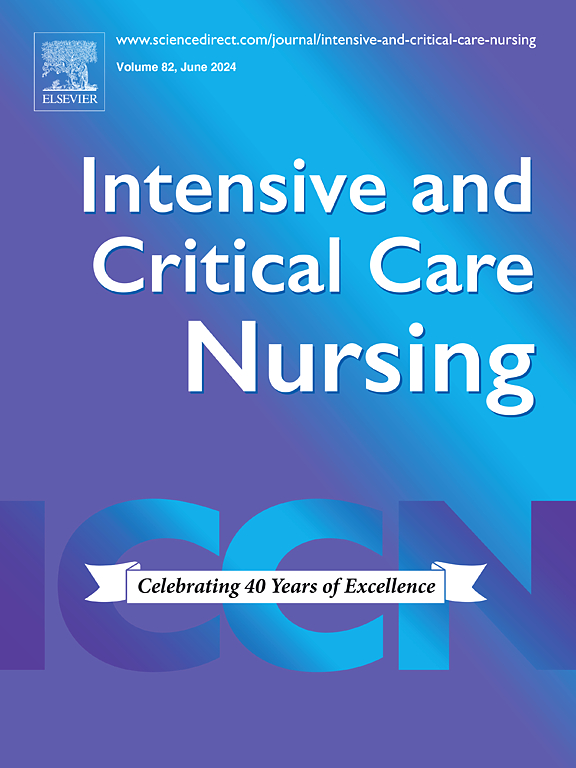Noise reduction interventions in intensive care units: a systematic review
IF 4.7
2区 医学
Q1 NURSING
引用次数: 0
Abstract
Objectives
This systematic review aimed to examine the impact of noise reduction interventions on objectively measured noise levels, as well as associated clinical and perceptual outcomes for patients and healthcare professionals (HCPs) in intensive care units (ICUs).
Methods
A systematic search of six electronic databases (PubMed, CINAHL, EMBASE, Web of Science, Cochrane Library, and Scopus) was conducted for studies published between January 2015 and December 2024. The review followed the Cochrane Handbook for Systematic Reviews and adhered to the Preferred Reporting Items for Systematic Reviews and Meta-Analyses reporting guidelines, and eligible studies were independently evaluated for quality assessment.
Results
Of the screened publications, 12 met the inclusion criteria, including randomized controlled trials (RCTs) (n = 2) and quasi-experimental studies (n = 10). Various interventions have been implemented to mitigate ICU noise, which are classified into three categories: patient-directed interventions (e.g., earplugs), environmental modifications (e.g., soundproofing), HCP-oriented interventions (e.g., education, behavioral changes), and multi-component interventions. The intervention period ranged from less than one day to four months. Outcome variables included noise level, sleep quality, physiological response, and HCP perception.
Conclusions
ICU noise reduction interventions showed variable effectiveness, with multi-component approaches to address multiple noise sources. While interventions reduced noise levels and improved patient outcomes, noise levels often remained above the World Health Organization (WHO) standards. Evaluations of effectiveness have primarily been short-term, limiting analysis of sustained effects. To create a more conducive ICU environment for both patients and HCPs, future studies should focus on long-term effectiveness and include well-designed RCTs to strengthen the evidence base for noise management.
Implications for clinical practice
Implementing noise reduction interventions, including HCP education, environmental modifications, and multi-component approaches, can improve ICU patient care and HCP well-being. Healthcare organizations should prioritize sustainable noise management strategies and conduct ongoing monitoring to ensure long-term effectiveness in ICUs.
重症监护病房的降噪干预:系统回顾。
目的:本系统综述旨在研究降噪干预对客观测量噪声水平的影响,以及重症监护病房(icu)患者和医疗保健专业人员(HCPs)的相关临床和感知结果。方法:系统检索PubMed、CINAHL、EMBASE、Web of Science、Cochrane Library和Scopus 6个电子数据库,检索2015年1月至2024年12月间发表的研究。本综述遵循Cochrane系统评价手册,并遵循系统评价和meta分析报告指南的首选报告项目,并对符合条件的研究进行独立的质量评估。结果:在筛选的出版物中,12篇符合纳入标准,包括随机对照试验(rct) (n = 2)和准实验研究(n = 10)。已经实施了各种干预措施来减轻ICU的噪音,这些干预措施分为三类:以患者为导向的干预措施(如耳塞)、环境改造(如隔音)、以hcp为导向的干预措施(如教育、行为改变)和多组分干预措施。干预期从不到一天到四个月不等。结果变量包括噪音水平、睡眠质量、生理反应和HCP感知。结论:ICU降噪干预具有不同的效果,采用多成分方法来解决多个噪声源。虽然干预措施降低了噪音水平并改善了患者的预后,但噪音水平往往仍高于世界卫生组织(世卫组织)的标准。对有效性的评价主要是短期的,限制了对持续效果的分析。为了为患者和医护人员创造一个更有利的ICU环境,未来的研究应关注长期有效性,并包括设计良好的随机对照试验,以加强噪音管理的证据基础。对临床实践的启示:实施降噪干预,包括HCP教育、环境改造和多成分方法,可以改善ICU患者护理和HCP幸福感。医疗保健组织应优先考虑可持续噪声管理策略,并进行持续监测,以确保icu的长期有效性。
本文章由计算机程序翻译,如有差异,请以英文原文为准。
求助全文
约1分钟内获得全文
求助全文
来源期刊

Intensive and Critical Care Nursing
NURSING-
CiteScore
6.30
自引率
15.10%
发文量
144
审稿时长
57 days
期刊介绍:
The aims of Intensive and Critical Care Nursing are to promote excellence of care of critically ill patients by specialist nurses and their professional colleagues; to provide an international and interdisciplinary forum for the publication, dissemination and exchange of research findings, experience and ideas; to develop and enhance the knowledge, skills, attitudes and creative thinking essential to good critical care nursing practice. The journal publishes reviews, updates and feature articles in addition to original papers and significant preliminary communications. Articles may deal with any part of practice including relevant clinical, research, educational, psychological and technological aspects.
 求助内容:
求助内容: 应助结果提醒方式:
应助结果提醒方式:


